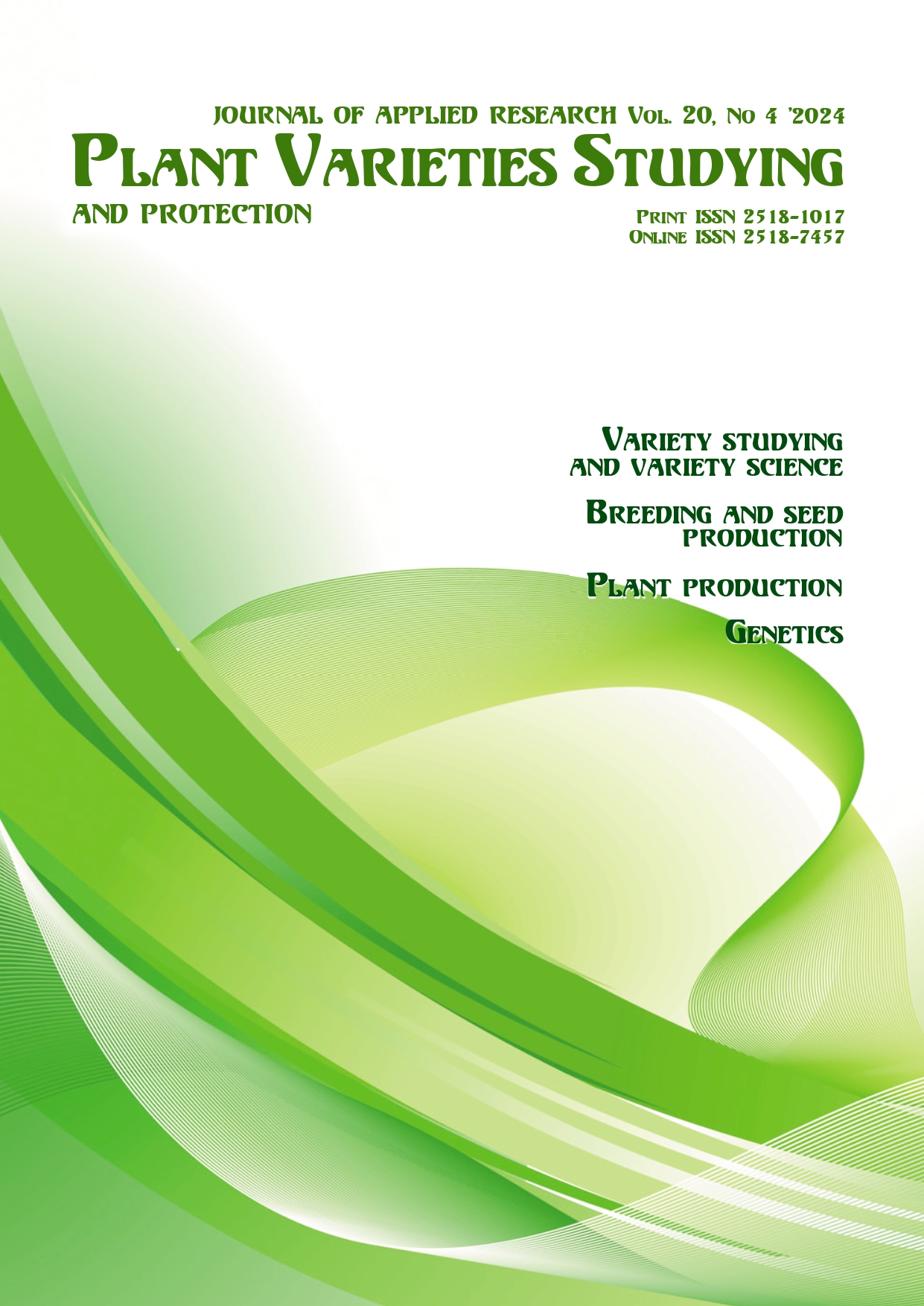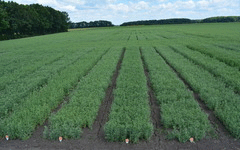New varieties of Oriental poppy (Papaver orientale L.) bred in the M. M. Gryshko National Botanical Garden of the National Academy of Sciences of Ukraine
DOI:
https://doi.org/10.21498/2518-1017.20.4.2024.320937Keywords:
Papaveraceae Juss., ornamental plants, hybridisation, assortment, phytodesignAbstract
Purpose. Based on the analysis of scientific literature and information resources of botanical institutions, to investigate the state and main directions of Oriental poppy (Papaver orientale L.) breeding, as well as the world assortment of its varieties. Based on the collection and breeding stock of the M.M. Gryshko National Botanical Garden of the National Academy of Sciences of Ukraine (hereinafter – NBG), to create domestic varieties that meet the requirements for modern ones and are adapted to the growing conditions in Ukraine. Methods. Analytical selection methods were used, based on individual selection and evaluation of the best samples from the available breeding base. Results. Eight new varieties of Oriental poppy of the NBG breeding ‘Lialechka’, ‘Rozett’, ‘Malika’, ‘Kabare’, ‘Miia’, ‘Halyna’, ‘Chaklunka’, ‘Toreador’) are presented. They are characterised by considerable variability in morphological traits, including color, flower shape, habitus and plant height. The diameter of the flowers varies from 8 to 18 cm, the shape – from bowl to cup, the degree of ruffle of the petals varies from weak to strong. The strength of the flower peduncles correlates with the height of the plants, ensuring the stability and decorativeness of both tall and short varieties. Conclusions. The new varieties of Oriental poppy of the NBG breeding are characterised by high decorative value, resistance to abiotic and biotic factors and adaptability to the soil and climatic conditions of the Ukrainian forest steppe. They also show considerable variability in habit, flower shape and color, and have different flowering times and durations. These characteristics make the newly developed varieties promising for multiple uses in landscaping and for further use in breeding programmes. Eight new varieties have been included in the “State Register of Plant Varieties Suitable for Dissemination in Ukraine”.
Downloads
References
Muzychuk, H. M., Horai, H. O., & Shevera, M. V. (2008). Forecasting of success and economic perspectivity of introduction of Papaveraceae family ornamental plants (Papaveraceae Juss.) in Lisostep and Polissіa zones of Ukraine. Industrial Botany, 8, 115–132. [In Ukrainian]
Griffiths, M. (1994). Index of Garden Plants. Oregon: Timber Press.
Brickell, Ch. (2019). RHS Encyclopedia of Plants and Flowers. London: Dorling Kindersley.
Sariyar, G. (2002). Biodiversity in the alkaloids of Turkish Papaver species. Pure and Applied Chemistry, 74(4), 557–574. doi: 10.1351/pac200274040557

Böhm, H., & Nixdorf, H. (1983). Qualität und Quantität von Morphinan-Alkaloiden in Artbastarden der Gattung Papaver. Planta Medica, 48(8), 193–204. doi: 10.1055/s-2007-969920
 |
| 
Kunakh, V. A., & Katsa, V. A. (2003). Biosynthesis of isoquinoline alkaloids in poppies in nature and in vitro cultures. 1. Opium poppy (Papaver somniferum L.). Ukrainian Biochemical Journal, 75(5), 41–54. [In Ukrainian]
Kunakh, V. A., & Katsa, V. A. (2004). Biosynthesis of quinolone alkaloids in poppies in nature and in vitro cultures. 2. (Papaver bracteatum Lindl.). Ukrainian Biochemical Journal, 76(5), 29–44. [In Ukrainian]
Grey-Wilson, C. (2000). Poppies: The Poppy Family in the Wild and in Cultivation. London: B.T. Batsford LTD.
Goldblatt, P. (2011). A new name for Papaver pseudo-orientale (Papaveraceae). Novon: A Journal for Botanical Nomenclature, 21(2), Article 182. doi: 10.3417/2009134

Goldblatt, P. (1974). Biosystematic studies in Papaver section Oxytona. Annals of the Missouri Botanical Garden, 61(2), 264–296. doi: 10.2307/2395056
Kadereit, J. W. (1988). Sectional affinities and geographical distribution in the genus Papaver L. (Papaveraceae). Beitrage zur Biologie der Pflanzen, 63(1–2), 139–156.
Ojala, A., Rousi, A., Lewing, E., Pyysalo, H., & Widén, C.-J. (2008). Interspecific hybridization in Papaver. III. F1 hybrids between species of sect. Oxytona. Hereditas, 112(3), 221–230. doi: 10.1111/j.1601-5223.1990.tb00061.x

Levy, A., & Milo, J. (1991). Inheritance of morphological and chemical characters in interspecific hybrids between Papaver bracteatum and Papaver pseudo-orientale. Biomedical and Life Sciences, 81(4), 537–540. doi: 10.1007/BF00219446
 |
| 
Lack, H. W. (2019). The discovery and naming of Papaver orientale s.l. (Papaveraceae) with notes on its nomenclature and early cultivation. Candollea, 74(1), 47–64. doi: 10.15553/c2019v741a7

Grey-Wilson, C. (1998). Sensation poppies on trial: Oriental glories. The Garden, 5, 320–326.
Verschoor, J. (n.d.). Papaver. Retrieved from https://www.verschoorperennials.com/papaver/
Papaver Patents (Class PLT/464). Retrieved from https://patents.justia.com/patents-by-us-classification/PLT/464
Royal Horticultural Society. (n.d.). Papaver ‘Medallion’ (Super Poppy Series). Retrieved from https://www.rhs.org.uk/plants/154394/papaver-medallion-(super-poppy-series)/details
Stehr, S. (n.d.). Türkischer Mohn Papaver orientale. Retrieved from https://www.mein-schoener-garten.de/pflanzen/mohn/tuerkischer-mohn
Gräfin von Zeppelin Staudengärtnerei. Retrieved from https://graefin-von-zeppelin.de/
Garibaldi, A., Minuto, A., Bertetti, D., & Gullino, M. L. (2003). First report of Peronospora arborescens as the causal agent of downy mildew on Papaver nudicaule in Italy. Plant Disease, 87(10), Article 1265. doi: 10.1094/PDIS.2003.87.10.1265B

Bernath, J. (Ed.). (1998). Poppy: The Genus Papaver. London: CRC Press. doi: 10.1201/9780203304181
Mashkovska, S. P. (Ed.). (2015). Catalog of ornamental and herbaceous plants of botanical gardens and arboretums of Ukraine. Kyiv. Retrieved from http://www.nbg.kiev.ua/upload/biblio/katalog.pdf [In Ukrainian]
Kohnno, N. A. (1997). Catalog of plants of the N. N. Gryshko Central Botanical Garden Named: A Reference Guide. Kyiv: Naukova Dumka. [In Russian]
Shyman, L. M. (1958). Summary of the physical-geographical characteristics of the Botanical Garden of the Academy of Sciences of the USSR. In Plant Acclimatization (pp. 70–87). Kyiv. [In Russian]
Bilyk, M. V. (1988). Changes in agrochemical indicators of soils during intensive cultivation of ornamental plants. In Agrochemical and Soil Research in Botanical Gardens (pp. 4–8). Apatity.
Sobko, V. H., & Gaponenko, M. B. (1996). Introduction of rare and endangered plants of the flora of Ukraine. Kyiv: Naukova Dumka. [In Ukrainian]
Central Geophysical Observatory Named After Borys Sreznevskyi. (n.d.). Climatic data for the city of Kyiv. Retrieved from http://cgo-sreznevskyi.kyiv.ua/uk/diialnist/klimatolohichna/klimatychni-dani-po-kyievu [In Ukrainian]
Buchinskyi, I. E. (1963). The Climate of Ukraine in the Past, Present, and Future. Kyiv: Gosselkhozizdat USSR. [In Russian]
Horai, H. O. (2017). Methodology for examination of poppy varieties (Papaver orientale L.) for distinction, homogeneity and stability. In Methodology of examination of varieties of ornamental plants for distinction, homogeneity and stability (pp. 1115–1131). Kyiv. Retrieved from https://www.sops.gov.ua/uploads/page/Meth_DUS/2023/Method_decors_2023_new_v.2.pdf [In Ukrainian]
Published
How to Cite
Issue
Section
License
Copyright (c) 2024 H. O. Horai

This work is licensed under a Creative Commons Attribution-ShareAlike 4.0 International License.
Starting in 2022, the copyright to the publication remains with the authors
Our journal abides by the CREATIVE COMMONS copyright rights and permissions for open access journals.
Authors, who are published in this journal, agree to the following conditions:
- The authors reserve the right to authorship of the work and pass the first publication right of this work to the journal under the terms of a Creative Commons Attribution License, which allows others to freely distribute the published research with the obligatory reference to the authors of the original work and the first publication of the work in this journal.
- The authors have the right to conclude separate supplement agreements that relate to non-exclusive work distribution in the form in which it has been published by the journal (for example, to upload the work to the online storage of the journal or publish it as part of a monograph), provided that the reference to the first publication of the work in this journal is included.

























 Ukrainian Institute for Plant Varieties Examination
Ukrainian Institute for Plant Varieties Examination  Селекційно-генетичний інститут
Селекційно-генетичний інститут Institute of Plant Physiology and Genetics of the National Academy of Sciences of Ukraine
Institute of Plant Physiology and Genetics of the National Academy of Sciences of Ukraine
 The National Academy of Agrarian Sciences of Ukraine
The National Academy of Agrarian Sciences of Ukraine